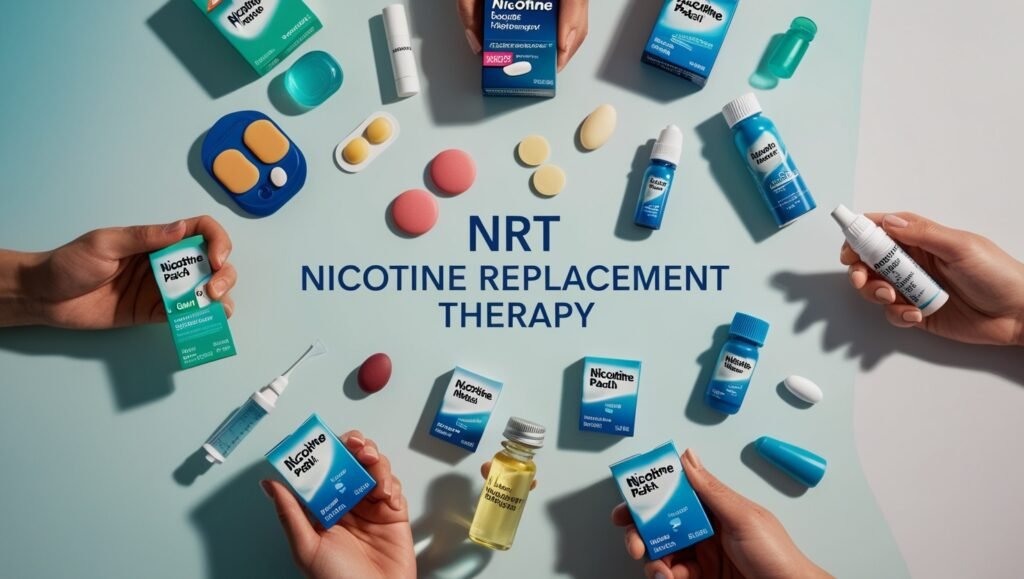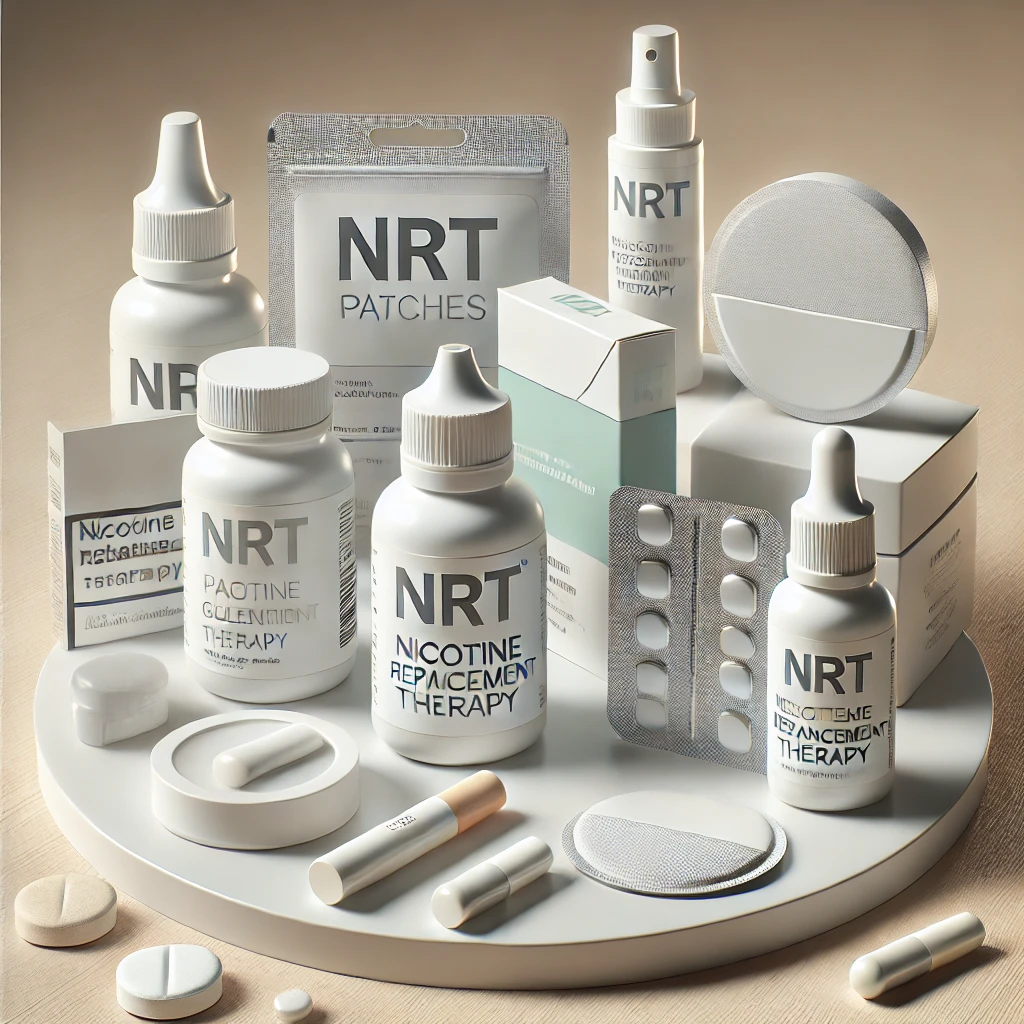Introduction
If you search for the most effective ways to quit smoking, Nicotine Replacement Therapy (NRT) might be the solution you’ve been looking for. With so many products available—from patches to gums and even nasal sprays—NRT has become one of the most popular and effective tools for helping smokers break free from nicotine dependence. But what exactly is NRT, and how does it work?
In this ultimate guide, we’ll delve into the science behind NRT, explore its benefits, and provide tips on choosing the best method for your lifestyle. Whether you’re a light or heavy smoker, NRT can be tailored to suit your needs, making the journey to becoming smoke-free less daunting and more achievable. By the end of this guide, you’ll have a comprehensive understanding of how NRT can support you every step of the way, from managing cravings to celebrating milestones. Ready to learn how NRT could be your key to a healthier, smoke-free life? Let’s get started.
Table of Contents
Nicotine Replacement Therapy (NRT)
1. Understanding Nicotine Replacement Therapy (NRT)
If you’re thinking about quitting smoking, you might have already heard about Nicotine Replacement Therapy, or NRT. But what exactly is it, and why is it so effective? NRT is a medically approved method of delivering small, controlled amounts of nicotine to the body, without the harmful chemicals found in cigarettes. The goal? To reduce the uncomfortable cravings and withdrawal symptoms that come with quitting smoking, making it easier to say goodbye to cigarettes for good.

What is Nicotine Replacement Therapy and How Does it Work?
NRT works by supplying your body with a low dose of nicotine that can help ease the transition to a smoke-free life. Unlike cigarettes, which deliver nicotine along with toxins like tar and carbon monoxide, NRT products contain only nicotine, minimizing health risks while targeting your cravings. By using NRT, you’re gradually reducing your body’s dependence on nicotine in a controlled, steady way. Here’s a closer look at how this approach helps:
- Reduces withdrawal symptoms – NRT delivers just enough nicotine to stave off withdrawal, making it easier to stick to your plan.
- Minimizes cravings – It helps you focus on behavioral changes without the distraction of intense cravings.
- Gradual reduction – By slowly lowering nicotine intake, your body can adjust to life without cigarettes more comfortably.
Types of NRT Products: Patches, Gums, Lozenges, Inhalers, and Nasal Sprays
NRT offers a variety of products, each designed to cater to different needs and preferences. Here’s a breakdown of the most common options:
- Provides a steady release of nicotine throughout the day.
- Ideal for those looking for consistent support without frequent administration.
Nicotine Gum
- Offers quick relief from cravings when they hit.
- Chewing the gum releases nicotine gradually, helping to control dosage.
Nicotine Lozenges
- Works similarly to gum but dissolves slowly in the mouth.
- Suitable for individuals who may not want to chew but need immediate relief.
Nicotine Inhalers
- Mimics the hand-to-mouth action of smoking, addressing both physical and psychological needs.
- Allows users to control the amount of nicotine inhaled with each use.
Nicotine Nasal Sprays
- Provides rapid nicotine delivery directly through the nasal membranes.
- Best suited for those with intense cravings who need fast-acting relief.
Each option has its unique advantages, and many people find success by combining multiple NRT products to manage cravings and withdrawal more effectively.
The Science Behind NRT: Reducing Withdrawal Symptoms and Cravings
Why does NRT work so well? It’s all about the balance. When you quit smoking, your body misses the nicotine it has come to rely on, resulting in withdrawal symptoms that can make quitting feel overwhelming. By supplying a controlled amount of nicotine, NRT helps prevent these withdrawal symptoms and cravings from taking over. You’re then able to focus on building new habits and addressing the psychological aspects of smoking without the physical strain.
Overall, NRT provides a safer, evidence-backed method to quit smoking without diving straight into withdrawal. By understanding how NRT works and exploring the various options, you’ll be better equipped to choose the path that suits you best on your journey toward a smoke-free life.
2. Benefits of Using Nicotine Replacement Therapy (NRT)
Are you wondering if Nicotine Replacement Therapy (NRT) is really worth it? For many, NRT has been a game-changer, significantly improving their chances of quitting smoking for good. But what are the specific benefits, and why has NRT become one of the most trusted tools in smoking cessation? Let’s take a look at the advantages NRT can bring to your quit journey.
How NRT Improves Smoking Cessation Success Rates
One of the most significant benefits of Nicotine Replacement Therapy is its proven effectiveness in increasing your odds of successfully quitting smoking. Studies show that using NRT can double your chances of quitting compared to going cold turkey. Here’s why:
- Gradual reduction in nicotine – By providing small, controlled doses of nicotine, NRT eases the transition away from smoking, helping you gradually reduce your dependency.
- Improved willpower – NRT helps curb the intense cravings that make quitting feel impossible, giving you the mental clarity and focus to stay on track.
- Supports long-term success – By minimizing withdrawal symptoms, NRT makes it easier to build sustainable habits without relying on cigarettes.
Reduced Health Risks Compared to Smoking
Smoking exposes you to thousands of harmful chemicals, many of which are linked to cancer, heart disease, and respiratory issues. NRT, on the other hand, delivers nicotine without these dangerous toxins, which significantly reduces your health risks. With NRT:
- You’ll breathe easier and reduce your risk of lung issues.
- Heart health improves as you avoid chemicals like carbon monoxide and tar.
- Your body can start repairing itself sooner, with noticeable improvements in circulation and overall energy.
Switching to NRT allows your body to recover from smoking damage while still addressing nicotine cravings, making it a much safer choice for your health.
Customizable Options for Different Needs
One of the biggest challenges with quitting smoking is finding a solution that works with your lifestyle and specific needs. NRT offers flexibility, allowing you to choose from various products (or even combine them) to fit your daily routine. Whether you prefer the steady support of a nicotine patch or the quick relief of nicotine gum or lozenges, there’s an option for you. NRT allows you to:
- Customize your quit strategy – Tailor the nicotine dose and delivery method to match your cravings and lifestyle.
- Adjust as you progress – Start with a higher dose and gradually reduce it, transitioning to lower levels of nicotine until you’re smoke-free.
- Mix and match products – Some people find success by combining products, such as using a patch for steady relief and gum for sudden cravings.
Convenience and Ease of Use
Quitting smoking can feel overwhelming, but NRT is designed to be straightforward and user-friendly. Most products are easy to find, require minimal setup, and offer clear instructions for use. Plus, the convenience of NRT makes it easier to manage cravings on the go, whether you’re at work, home, or out with friends.

Psychological and Emotional Support
The journey to quit smoking isn’t just physical; it’s emotional, too. NRT can play a crucial role in helping you manage the psychological challenges of quitting. By reducing cravings and withdrawal symptoms, NRT allows you to focus more on your emotional well-being and the lifestyle changes that will support long-term success.
Using NRT doesn’t just make quitting possible—it makes it sustainable. The benefits of NRT extend beyond the physical; they empower you to take control of your life and health, one step at a time.
3. Choosing the Right NRT Method for You
With so many Nicotine Replacement Therapy (NRT) options available, how do you figure out which one is right for you? Choosing the best method depends on your lifestyle, smoking habits, and personal preferences. The good news is that NRT is flexible and customizable, offering something for everyone. In this section, we’ll break down the factors to consider and help you navigate the choices to find your perfect match.
Factors to Consider When Choosing Nicotine Replacement Therapy method
Before you pick an NRT product, it’s important to evaluate your unique needs. Ask yourself:
- What are your smoking habits?
- Are you a heavy smoker needing consistent support? A nicotine patch might be ideal.
- Do you face sudden cravings during specific times of the day? A fast-acting option like gum or lozenges could work better.
- What’s your daily routine?
- If you’re always on the go, portable options like lozenges or an inhaler may be most convenient.
- For a discreet, low-maintenance option, consider a patch or nasal spray.
- Do you need psychological support?
- If the hand-to-mouth action of smoking is a big part of your habit, a nicotine inhaler can help address that behavioral need.
By identifying these factors, you can narrow down your choices and select an NRT product that complements your lifestyle.
Comparing Short-Acting vs. Long-Acting NRT Options
Not all NRT products work the same way. Some provide a steady release of nicotine, while others deliver quick relief for sudden cravings. Let’s compare:
Long-acting options (like nicotine patches):
- Provide a consistent level of nicotine throughout the day.
- Ideal for those who need all-day support and fewer reminders to manage cravings.
Short-acting options (like gum, lozenges, inhalers, or nasal sprays):
- Deliver nicotine quickly to address intense cravings.
- Perfect for those who experience unpredictable triggers or need on-demand relief.
For many, combining both types can offer the best of both worlds. For example, you could use a patch for steady control and gum or lozenges for immediate cravings.
Consulting Healthcare Professionals for Personalized Advice
If you’re still unsure which NRT method is best, don’t hesitate to seek guidance from a healthcare provider. Doctors and pharmacists can help you:
- Assess your smoking history and nicotine dependency level.
- Recommend the right dosage and product type for your needs.
- Monitor your progress and adjust your NRT plan if necessary.
Professional support can make all the difference, especially if you’ve struggled to quit smoking before or have underlying health conditions.
Take the First Step Toward Your Quit Journey
The key to quitting smoking successfully is finding an NRT method that aligns with your habits and goals. By evaluating your options and seeking professional advice when needed, you’re setting yourself up for a smoother, more effective path to becoming smoke-free. Remember, the right NRT product isn’t just about easing cravings—it’s about giving you the confidence and control to reclaim your health.
4. Tips for Maximizing the Effectiveness of Nicotine Replacement Therapy
You’ve chosen your Nicotine Replacement Therapy (NRT) method—now what? The journey to quitting smoking isn’t just about picking the right product; it’s about using it effectively to overcome cravings and build healthier habits. In this section, we’ll explore practical tips to ensure your NRT works its magic while keeping you motivated and on track.

Follow the Instructions for Proper Use
Every NRT product comes with its own set of instructions, and sticking to them is crucial for success. Misusing NRT—whether taking too much or too little—can lead to unnecessary setbacks. Here’s how to get it right:
Nicotine patches:
- Apply the patch to clean, dry skin. Rotate application sites daily to avoid irritation.
- Wear it for the recommended duration (usually 16-24 hours).
Nicotine gum:
- Chew the gum slowly until you feel a tingling sensation, then park it between your cheek and gum.
- Avoid eating or drinking for 15 minutes before and after use.
Lozenges, inhalers, or nasal sprays:
- Use only as directed and avoid exceeding the recommended daily dosage.
Taking a few extra minutes to read the instructions carefully can make a huge difference in how well your NRT works.
Combine NRT with Behavioral Strategies
While NRT helps manage the physical side of nicotine addiction, addressing the emotional and behavioral triggers is equally important. Here’s how you can reinforce your quit journey:
- Identify your triggers:
- Is it your morning coffee or stress at work that makes you crave a cigarette? Write down your triggers and plan alternative actions.
- Create a quit-smoking plan:
- Set small milestones, celebrate victories, and remind yourself why you’re quitting.
- Adopt healthy distractions:
- Try chewing sugar-free gum, going for a walk, or practicing deep breathing exercises when cravings hit.
Combining NRT with these strategies not only strengthens your resolve but also helps you build a smoke-free routine.
Be Patient with the Process
Quitting smoking is a journey, not an overnight transformation. It’s natural to experience ups and downs along the way. Here’s what to keep in mind:
- Stay consistent:
- Use your NRT products regularly and as prescribed. Skipping doses can lead to stronger cravings and make quitting harder.
- Give yourself grace:
- If you slip up and have a cigarette, don’t let it derail your progress. Learn from the experience and refocus on your goals.
- Track your progress:
- Keep a journal or use a quit-smoking app to monitor your success. Seeing how far you’ve come can be incredibly motivating.
Pair Nicotine Replacement Therapy with Professional Support
Using NRT alongside professional support can significantly boost your chances of quitting for good. Resources like counseling, quitlines, and support groups can provide:
- Emotional encouragement to help you stay committed.
- Practical advice for managing cravings and stress.
- Personalized strategies tailored to your unique challenges.
Quitting smoking is hard, but you don’t have to do it alone. Whether it’s through a therapist or a supportive friend, reaching out can make all the difference.
Celebrate Your Progress
Every day you stay smoke-free is a win, and recognizing your progress keeps you motivated. Treat yourself to small rewards, like a movie night or a new book, to celebrate milestones. Remember, you’re investing in a healthier, smoke-free future—one step at a time.
By following these tips, you can maximize the benefits of NRT and confidently tackle the challenges of quitting. With patience, persistence, and the right strategies, a smoke-free life is well within your reach.
5. Common Challenges with Nicotine Replacement Therapy and How to Overcome Them
Nicotine Replacement Therapy (NRT) is a powerful tool for quitting smoking, but like any process, it comes with its own set of challenges. From unexpected side effects to emotional hurdles, understanding these obstacles and knowing how to tackle them can make all the difference in your journey. Let’s dive into some common difficulties and strategies to overcome them.
Experiencing Side Effects
Some people may experience mild side effects when starting NRT. While these reactions are typically harmless, they can be frustrating. Here’s how to address them:
Skin irritation from patches:
- Rotate application sites daily and avoid placing the patch on irritated or broken skin.
- Use a hypoallergenic adhesive if sensitivity persists.
Mouth or throat discomfort from gum or lozenges:
- Use the product as directed (e.g., chew nicotine gum slowly to avoid excessive release).
- Consider switching to another form, like an inhaler, if discomfort continues.
Hiccups or nausea:
- Often a result of swallowing excess nicotine. Slow down usage and follow the recommended guidelines for the product.
If side effects persist or worsen, consult a healthcare provider to explore alternative solutions.
Dealing with Cravings and Triggers
Even with NRT, cravings can still surface, especially in high-stress situations or during exposure to triggers. Here’s how to stay prepared:
Have a plan for triggers:
- Identify your most common triggers (e.g., social events, alcohol) and develop strategies to avoid or manage them.
- For example, replace a post-meal cigarette with a brisk walk or a cup of herbal tea.
Use short-acting NRT effectively:
- Keep lozenges or gum handy for moments when cravings strike unexpectedly.
Practice mindfulness techniques:
- Deep breathing, meditation, or even a quick grounding exercise can help redirect your focus away from cravings.
Staying Motivated Over Time
The initial excitement of quitting can fade, leaving room for doubt or discouragement. Keeping your motivation high is essential. Here’s how:
Set achievable milestones:
- Break your quit journey into smaller goals, like staying smoke-free for one week, then one month, and so on.
- Celebrate these wins with rewards, like treating yourself to something you’ve been wanting.
Visualize your success:
- Remind yourself why you’re quitting. Whether it’s for your health, family, or personal freedom, keeping your “why” in focus can reignite your determination.
Lean on your support system:
- Share your progress with friends or family. Their encouragement can keep you motivated during tough times.
Overcoming Emotional Challenges
Quitting smoking can stir up strong emotions, from anxiety to irritability. While Nicotine Replacement Therapy helps with the physical addiction, managing your emotional well-being is just as important.
Recognize withdrawal symptoms:
- Mood swings and irritability are common but temporary. They indicate your body is healing from nicotine dependence.
- Stay patient with yourself and those around you during this phase.
Adopt stress-relief activities:
- Exercise, journaling, or even picking up a hobby can provide a positive outlet for emotional stress.
Seek professional help if needed:
- A counselor or therapist can offer valuable tools to manage stress and build resilience.
When to Seek Additional Help
If you’re struggling despite using NRT, don’t hesitate to seek extra support. A healthcare provider can:
- Assess your NRT dosage to ensure it’s meeting your needs.
- Recommend combining NRT with prescription medications for added effectiveness.
- Offer guidance on quitting strategies tailored to your situation.
FAQs About Nicotine Replacement Therapy (NRT)
1. What is Nicotine Replacement Therapy (NRT)?
- Answer: NRT is a treatment designed to help people quit smoking by delivering small, controlled doses of nicotine to reduce cravings and withdrawal symptoms. It comes in various forms, such as patches, gum, lozenges, inhalers, and nasal sprays, each catering to different preferences and needs.
2. How does Nicotine Replacement Therapy work?
- Answer: NRT works by providing a low level of nicotine without the harmful chemicals found in cigarettes. This controlled nicotine dose helps ease withdrawal symptoms and cravings, making it easier for smokers to quit gradually.
3. Is Nicotine Replacement Therapy safe?
- Answer: Yes, NRT is considered safe for most people when used as directed. It provides a much lower dose of nicotine than cigarettes, without the carcinogens and other toxic chemicals in tobacco smoke. However, individuals with certain health conditions should consult their doctor before starting NRT.
4. Can I use more than one form of Nicotine Replacement Therapy at once?
- Answer: Yes, combining different forms of NRT can be effective, especially for heavy smokers. For example, you might use a nicotine patch for steady, background relief and gum or lozenges for sudden cravings. It’s best to consult a healthcare provider before combining NRT products.
5. How long should I use Nicotine Replacement Therapy?
- Answer: The recommended duration varies depending on the product and your needs, but most people use NRT for 8-12 weeks. Some may need a shorter or longer period. The goal is to gradually reduce your nicotine use until you can quit completely.
6. Is it possible to become addicted to Nicotine Replacement Therapy?
- Answer: The risk of addiction to NRT is very low because NRT delivers lower, controlled doses of nicotine and lacks the quick “hit” of cigarettes. However, some people may use NRT longer than recommended; if this is a concern, talk to your healthcare provider.
7. Does NRT really improve my chances of quitting?
- Answer: Yes, research shows that NRT can double the likelihood of quitting successfully, especially when combined with support like counseling or behavioral therapy. NRT helps manage withdrawal symptoms, making the quitting process more manageable.
8. What are the side effects of Nicotine Replacement Therapy?
- Answer: Side effects are usually mild and vary by product. Common ones include skin irritation from patches, mouth or throat irritation from gum, and a mild tingling sensation from lozenges. More intense reactions are rare but should be discussed with a doctor if they occur.
9. Can pregnant or breastfeeding women use Nicotine Replacement Therapy?
- Answer: NRT is generally safer than smoking during pregnancy, but it should be used only under medical supervision. Pregnant or breastfeeding women should discuss options with their healthcare provider to choose the safest and most effective approach.
10. Will Nicotine Replacement Therapy work for everyone?
- Answer: NRT can significantly improve your chances of quitting, but it’s not guaranteed. Success with NRT varies and depends on factors like commitment to quitting, lifestyle adjustments, and support. Other treatments and behavioral strategies can further boost your success rate.
11. How do I know which NRT product is right for me?
- Answer: Your choice depends on your smoking habits, preferences, and lifestyle. For example, patches are convenient and provide steady nicotine release, while gum or lozenges offer flexibility for cravings. Consulting a healthcare professional can also help guide your choice.
12. Can I continue smoking while on Nicotine Replacement Therapy?
- Answer: NRT is designed to reduce nicotine dependence, so smoking while on NRT isn’t recommended. Smoking increases nicotine levels in your body, counteracting the effectiveness of NRT. Reducing or avoiding smoking entirely will yield the best results.
13. Does health insurance cover Nicotine Replacement Therapy?
- Answer: Coverage varies by insurance plan and region, but many plans cover at least some forms of NRT as part of smoking cessation benefits. Check with your insurance provider or a local health organization for details on coverage and support programs.
14. Where can I buy NRT products?
- Answer: NRT products are available at most pharmacies, drugstores, and online retailers. Some healthcare providers and government programs also offer free or discounted NRT to help people quit smoking.
15. What should I do if I experience side effects?
- Answer: Mild side effects are common and usually resolve on their own. If you experience persistent or severe symptoms, consider switching NRT forms or speak with a healthcare provider to adjust your plan.
Conclusion
Nicotine Replacement Therapy (NRT) can be a game-changer for those looking to quit smoking, offering a lifeline in the battle against nicotine addiction. If you’ve been struggling to quit, NRT provides an effective, proven method to manage cravings and reduce withdrawal symptoms, giving you the tools to reclaim control over your health.
But how do you know if NRT is the right choice for you? It’s important to recognize that quitting smoking is a personal journey. NRT might not be the only answer, but it’s a powerful ally. Whether you’re considering nicotine patches, gum, lozenges, or another form, NRT can support your efforts and boost your chances of success.
The key is to find a method that works best for your lifestyle and preferences. Have you tried other smoking cessation methods before? If so, NRT could complement those strategies and provide the support you need. If you haven’t yet started, there’s no better time than now to take that first step toward a smoke-free life.
As with any health decision, it’s always a good idea to consult a healthcare professional to ensure that you’re choosing the best approach for your specific needs. Remember, quitting smoking is not about perfection—it’s about progress, and NRT can help you along the way.
So, are you ready to break free from nicotine addiction? With NRT by your side, the path to a healthier, smoke-free future is within reach. Take the next step today and join the countless others who’ve found success in their quit-smoking journey. You’ve got this!
References
National Institute on Drug Abuse (NIDA). (2022). Nicotine. National Institutes of Health. Retrieved from https://nida.nih.gov
American Cancer Society. (2020). Nicotine Replacement Therapy (NRT). Retrieved from https://www.cancer.org
Centers for Disease Control and Prevention (CDC). (2021). How to Quit Smoking. Retrieved from https://www.cdc.gov
World Health Organization (WHO). (2021). Tobacco: Key Facts. Retrieved from https://www.who.int
U.S. Food and Drug Administration (FDA). (2021). Nicotine Replacement Therapies (NRTs) and Smoking Cessation. Retrieved from https://www.fda.gov
Mayo Clinic. (2022). Nicotine Replacement Therapy: Benefits and Side Effects. Retrieved from https://www.mayoclinic.org




